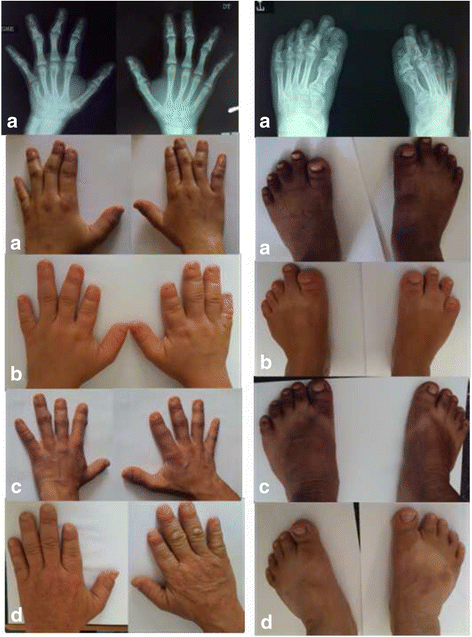A novel TRPS1 mutation in a Moroccan family with Tricho-rhino-phalangeal syndrome type III: case report
- PMID: 28468609
- PMCID: PMC5415804
- DOI: 10.1186/s12881-017-0413-8
A novel TRPS1 mutation in a Moroccan family with Tricho-rhino-phalangeal syndrome type III: case report
Abstract
Background: Tricho-rhino-phalangeal syndrome (TRPS) is an autosomal dominant disorder characterized by craniofacial and skeletal malformations including short stature, thin scalp hair, sparse lateral eyebrows, pear-shaped nose and cone shaped epiphyses. This condition is caused by haploinsufficiency of the TRPS1 gene. Previous genotype-phenotype studies have correlated exon 6 missense mutations with TRPS type III, a severe form of type I with pronounced, facial characteristics, short stature and brachydactyly and differing from type II by the absence of exostoses and mental retardation.
Case presentation: We report the first case of a Moroccan family, a father and his three children, in which the diagnosis of type III TRPS was suspected based on severe clinical and radiological features. Molecular analysis of the TRPS1 gene revealed a novel missense mutation in exon 6, (p.Ala932Ser), located in the GATA-type DNA-binding zinc finger domain.
Conclusion: Our observations in this kindred support the previous genotype-phenotype results suggesting that patients with more pronounced facial characteristics and more severe shortening of hands and feet are more likely to have mutation in exon 6 of TRPS1.
Keywords: Exon 6; Moroccan family; Novel missense mutation; TRPS1; Tricho-rhino-phalangeal syndrome type III.
Figures




Similar articles
-
Non-ossifying fibroma with a pathologic fracture in a 12-year-old girl with tricho-rhino-phalangeal syndrome: a case report.BMC Med Genet. 2018 Dec 12;19(1):211. doi: 10.1186/s12881-018-0732-4. BMC Med Genet. 2018. PMID: 30541476 Free PMC article.
-
Identification of two novel mutations in TRPS1 gene in families with tricho-rhino-phalangeal type I syndrome.J Investig Med. 2012 Jun;60(5):823-6. doi: 10.2310/JIM.0b013e318250b74c. J Investig Med. 2012. PMID: 22481165
-
Phenotype and genotype in 103 patients with tricho-rhino-phalangeal syndrome.Eur J Med Genet. 2015 May;58(5):279-92. doi: 10.1016/j.ejmg.2015.03.002. Epub 2015 Mar 16. Eur J Med Genet. 2015. PMID: 25792522
-
An early diagnosis of trichorhinophalangeal syndrome type 1: a case report and a review of literature.Ital J Pediatr. 2018 Nov 20;44(1):138. doi: 10.1186/s13052-018-0580-z. Ital J Pediatr. 2018. PMID: 30458885 Free PMC article. Review.
-
Trichorhinophalangeal Syndrome.2017 Apr 20 [updated 2024 Mar 21]. In: Adam MP, Feldman J, Mirzaa GM, Pagon RA, Wallace SE, Amemiya A, editors. GeneReviews® [Internet]. Seattle (WA): University of Washington, Seattle; 1993–2025. 2017 Apr 20 [updated 2024 Mar 21]. In: Adam MP, Feldman J, Mirzaa GM, Pagon RA, Wallace SE, Amemiya A, editors. GeneReviews® [Internet]. Seattle (WA): University of Washington, Seattle; 1993–2025. PMID: 28426188 Free Books & Documents. Review.
Cited by
-
Mapping of developmental dysplasia of the hip to two novel regions at 8q23-q24 and 12p12.Exp Ther Med. 2020 Apr;19(4):2799-2803. doi: 10.3892/etm.2020.8513. Epub 2020 Feb 11. Exp Ther Med. 2020. PMID: 32256763 Free PMC article.
-
Non-ossifying fibroma with a pathologic fracture in a 12-year-old girl with tricho-rhino-phalangeal syndrome: a case report.BMC Med Genet. 2018 Dec 12;19(1):211. doi: 10.1186/s12881-018-0732-4. BMC Med Genet. 2018. PMID: 30541476 Free PMC article.
-
Cis-regulatory control of mammalian Trps1 gene expression.J Exp Zool B Mol Dev Evol. 2024 Mar;342(2):85-100. doi: 10.1002/jez.b.23246. Epub 2024 Feb 18. J Exp Zool B Mol Dev Evol. 2024. PMID: 38369890 Free PMC article.
References
-
- Giedion A. Tricho-rhino-phalangeal syndrome [Article in German] Helv Paediatr Acta. 1966;21:475–85. - PubMed
-
- Giedion A, Burdea M, Fruchter Z, Meloni T, Trosc V. Autosomal-dominant transmission of the tricho-rhino-phalangeal syndrome. Report of 4 unrelated families, review of 60 cases. Helv Paediatr Acta. 1973;28:249–59. - PubMed
MeSH terms
Substances
Supplementary concepts
LinkOut - more resources
Full Text Sources
Other Literature Sources
Medical

